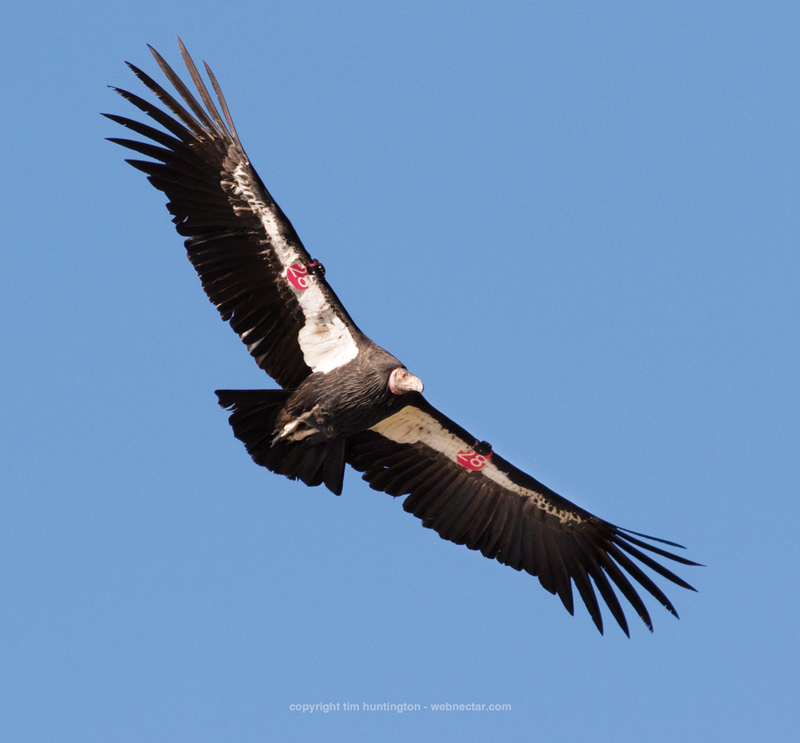Welcoming the condor back to Mount Diablo

CONTRA COSTA COUNTY, CA (Dec. 14, 2021) — For the first time in more than 100 years, North America’s largest land bird, the California condor, graced skies above the eastern slope of Mount Diablo this summer.
Condor No. 828, a 6-year-old female, left Pinnacles National Park, flew around Livermore Valley for a time, then explored Morgan Territory.
“She was probably looking for a nesting site,” posited Seth Adams, Save Mount Diablo’s land conservation director. “The cliffs and wind caves in the area are perfect condor habitat. I’ve been waiting my whole life for this. And I’m convinced this wouldn’t be happening if we and our allies – state parks, etc. – hadn’t protected a big strip of open space down the Diablo Range to Henry Coe and Pinnacles.”
Biologist Joe Burnett, California condor recovery program manager for the Ventana Wildlife Society (VWS), agrees. “The first time I saw Mount Diablo, I thought – this is condor country.”
VWS works with the U.S. Fish & Wildlife Service and the National Park Service in managing the program’s condor release sites in both Pinnacles and Big Sur. The historic flight of 828, the first wild-fledged bird in the Pinnacles Condor Recovery Program, reached farther north in western California than any other condor since the release program began in the 1990s. Conservationists and bird-lovers are hopeful that the birds will repopulate their bygone habitats in the Diablo Range and beyond.
The days of the thunderbird
California condors, New World vultures with an almost 10-foot wingspan, are relics of the Pleistocene Ice Age. They were once widespread across the country. But by the time of the Gold Rush, they had retreated west of the Rockies – surviving into the 20th century only in California. They figure prominently in the stories of many of California’s Indigenous tribes; “thunderbird” legends abound.
Over time, their numbers decreased dramatically due to DDT, poaching and habitat destruction, but most of all because of lead poisoning. The birds feed on carrion, which is often contaminated by the lead from hunters’ ammunition. California banned lead bullets in 2019, though the recent ammunition shortage has prompted some hunters to resort to using old, leaded stock. This has increased the lead poisoning of the critically endangered birds.
Hatching a rescue plan
In 1987, in a controversial and desperate attempt to save the species from certain extinction, the U.S. government implemented a bold conservation plan. They captured the 22 remaining birds and set up captive breeding programs at San Diego Wild Animal Park and the Los Angeles Zoo. The hope was that the birds’ offspring could eventually be reintroduced into the wild, tagged and fitted with tracking devices.
The project, one of the most expensive conservation efforts in U.S. history, has been successful. The population has grown steadily; released birds are nesting and reproducing in the wild, and they are expanding their range.
“This is a resilient species,” Burnett noted. “828 had to navigate the Altamont Pass, with its deadly (to birds) wind turbines. She flew 1,000 meters above them and just kept going. The timing of this remarkable flight is a gift of sorts. After a very rough 2020 – we lost 12 birds to wildfires – it was so great to see this bird take this incredible flight. She reminded us that we just have to keep fighting for them.”
Condors are primarily soarers. They flap their wings during take off and then glide for miles, relying on thermals to keep them aloft.
“Keep your eyes on the sky come next summer,” Burnett said. “Summer is the time for long flights, when thermals are at their peak. The condors will be back and, sometime soon, they’ll be back to stay.”

Pamela Michael
Pamela Michael is a writer and communications specialist who has lived in Curry Canyon for twenty years.
